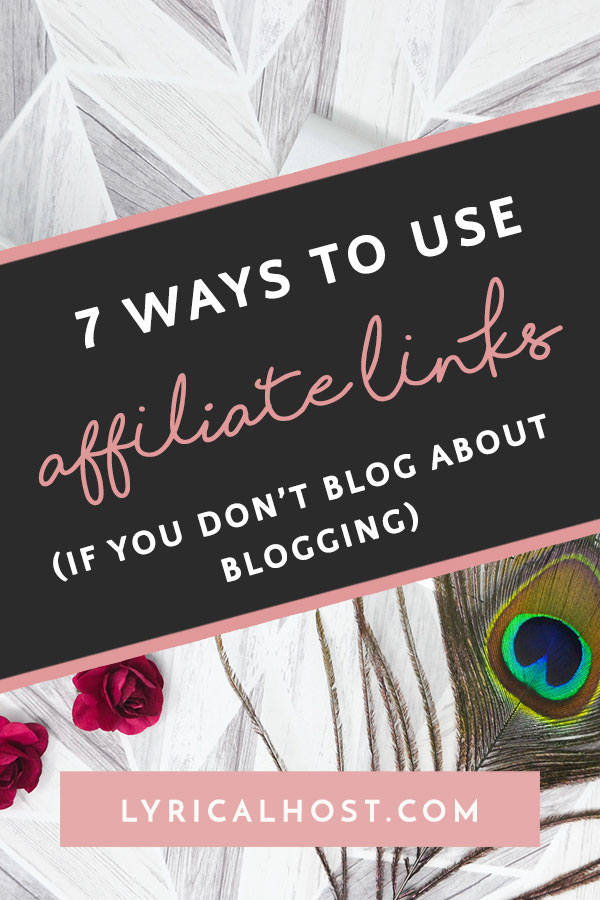It’s a commonly held myth that you need to write about blogging to earn money from your blog. One of the easiest ways to make money is through affiliate commission, so this post is all about how to incorporate affiliate links – particularly for tech products and services you use yourself as a blogger or business owner – into your online life even if you don’t blog about blogging.
As an added bonus, nearly all of these tips work with the Lyrical Host affiliate program!
Let’s get started.
Currently reading: 7 Ways To Use Affiliate Links If You Don't Blog About Blogging Share on X
Before we get started: When following these tips, please be sure to double check the current terms of the affiliate program you want to use. Some are stricter than others about how you’re allowed to promote them and where you’re allowed to place links. (Our affiliate program is very laid back, so don’t worry if you’re planning to promote us – you can use any of these tips!).
We also have a blog post on How To Disclose Affiliate Links, in case you need advice on that too.
Now the housekeeping’s out of the way, on with the tips!
01. On Twitter and Facebook
If you have a small audience, or you know they won’t be interested in the types of affiliate links you’re looking to promote, you’ll want to track down the communities that will be interested, and two of the best platforms for that are Twitter and Facebook. The key thing to remember is that it takes time to build up your reputation in any community; dropping links and running won’t get you sales.
Related: How To Get Affiliate Sales Even If You Don’t Get Much Traffic
Often relevant groups can be found with a simple search, and googling Twitter chats for relevant niches can give you information about times to show up. Searching the chat’s hashtags will give you an indication of how popular the chat is and when it was last active.
On both Facebook and Twitter, search for keywords in recent discussions of people looking for tips, and add your recommendations and reasons where appropriate. Search the brand on Twitter or Facebook from time to time to spot people asking for personal recommendations/experiences.
If you run your own Facebook group or other community, having a file/thread of resources with affiliate links can work well, especially when bumped or updated from time to time.
If you stick to the peak times of year when the product/service you’re recommending is most popular, you don’t have to spend much time on it for a good chance of a return. Ask the company you’re promoting when their peak times are if you aren’t sure.
02. A dedicated page
If affiliate links or specific affiliate programs won’t work for the kinds of blog posts you write, you could create a dedicated page on your website for recommendations. For example, this could be a Resources, Tools, or Credits page. You could even incorporate a link or two on your About page, if it covers information about your blog or website. Depending on what your visitors are interested in, you may not get a huge click through rate, but it’s also an easy way to quickly find and share your affiliate links in other ways!
03. Your site footer
Your website footer is a logical place to put “Powered by” types of links, which can work for a whole bunch of tech- and resource-related affiliate programs, including web hosting, domain names, your theme, stock photos, key plugins you use, your social media scheduler, and so on. Just don’t forget to declare them as affiliate links!
04. Your email signature
Try testing out affiliate links in your email signature. One at a time usually works best, and you won’t want to make it a huge full-on ad, but a single genuine recommendation doesn’t hurt. Another option is to selectively use affiliate links as a PS in your email marketing. Even skim readers tend to pay attention to a PS, and it’s an easy way to help it stand out from your other links.
05. Instagram stories
As Instagram and Facebook stories are only around for 24 hours and each screen is very short, people often accept pitches more naturally than on other platforms. It also adds more of a sense of urgency as people know if they don’t take action when they see it, they’re likely to forget about it until it’s too late.
There are different ways you could incorporate affiliate “links”; for example by creating a promotional story in between your other story screens, or by encouraging people to vote in a poll so you can contact . Create a short URL or a link in your bio if you don’t have the swipe up feature. Or if you’re promoting the Lyrical Host affiliate program, you could create a short, memorable discount code for people to use at checkout.
For a more natural approach, take some time to make them relevant to your story strategy or life, for example how your social media scheduler has freed up your time today, or how your web host has helped you out with an issue.
06. Resource library
If you have a resource library, you could include a section or download covering your favorite tools. You can always label it as a side note or recommendations. As people often like to check out everything in a resource library, it can be a good way to get extra eyeballs on your links without pushing them in your visitors’ faces.
A download can also feature a credits page at the end for things like graphics software and fonts. Just remember to keep your links up to date if they’re hidden away in a download!
07. LinkedIn
As LinkedIn is naturally more business-focused, it makes sense to create about the tools you use and how they help you run your blog or business. Just like with Twitter and Facebook, you can keep an eye out for relevant threads and search for communities you can add value in and mention your link or code once people know and trust you.
A final tip
If you have affiliate links in different places around the internet, be sure to keep a spreadsheet to track when and where you shared them. This stops you repeating them too much too often, and also makes it easier for you to delete old posts or check/update links as needed. Storing it in the cloud, for example as a Google Sheet, makes it super easy to access from any device, so you always have the links you need to hand (you could even keep some notes on features and benefits to make writing your recommendations even faster).
Found this post useful? Please pin it for someone else to discover!







No Comments